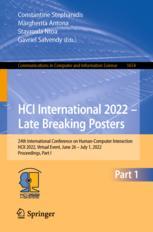موضوعات
آموزش و پرورش
ادبیات و زبان
پزشکی، دندانپزشکی و داروسازی
تاریخ و جغرافیا
داستان و رمان
دیگر
دین و فلسفه
روانشناسی
ریاضیات و آمار
سلامتی، تناسب اندام و رژیم غذایی
شیمی و پلیمر
علوم اجتماعی و حقوق
علوم زیستی و بیوتکنولوژی
فیزیک و نجوم
کامپیوتر و اینترنت
کتابهای کودکان و داستان
کسب و کار و اقتصاد
کشاورزی و دامپزشکی و غذا
معماری
مهندسی و فناوری
هنر و تئاتر
محصولات
HCI International 2022 – Late Breaking Posters - Original PDF
نویسندگان: خلاصه: 4 P. Asghari et al. 1 Introduction Eye tracking (ET) is frequently used, for example, in behavioral research and human-computer interaction. Eye movement patterns can reveal detailed infor- mation about the user’s cognitive processes, their attention level, or decision- making processes [3,12]. Applications and research based on ET require reliable and robust data [9]. Traditionally, this requires dedicated hardware with high- resolution cameras and infrared illumination to detect corneal reflections [7]. However, dedicated hardware is expensive and thus limits the pervasive use in real-world applications. This situation may change since, propelled by recent advances in deep learning, appearance-based gaze estimation methods that deliver promising results based on low-cost consumer-grade camera inputs start to emerge [2,10,11,21]. These approaches learn to estimate gazes from a video stream based on large-scale data sets and provide 3D gaze vectors or correspond- ing 2D gaze locations on a screen. Furthermore, they do not require any specific external devices and can be used with standalone computers, laptop built-in webcams, or mobile device consumer-grade cameras. This opens up the possi- bility of developing affordable automated intelligent ET solutions for research, commerce, and the general public. On the way to realize this ambition, webcam ET (wcET) has to address several challenges including gaze estimation accu- racy, gaze estimator prediction time, and that gaze estimation quality can be affected by user movements [11]. This paper aims to contribute to the first step toward utilizing wcET as a low-cost pervasive technology by validating the data quality of a state-of-the-art wcET approach in comparison to the performance of an established, commercially available dedicated eye tracking (dhET) system. Accordingly, we address the following research question in our work: How does the gaze estimates of wcET differ from dhET in practical settings regarding accu- racy, precision, and sampling rate? We will further discuss how the limitations of the data quality may affect the performance of wcET applicationsآیا کتاب مورد نظر هنوز بر روی سایت قرار نگرفته است؟ جای نگرانی نیست! کافی است بر روی گزینه سفارش کتاب کلیک کرده و درخواست خود را ثبت کنید. در کمتر از چند ساعت کتاب شما را آماده خواهیم کرد.

